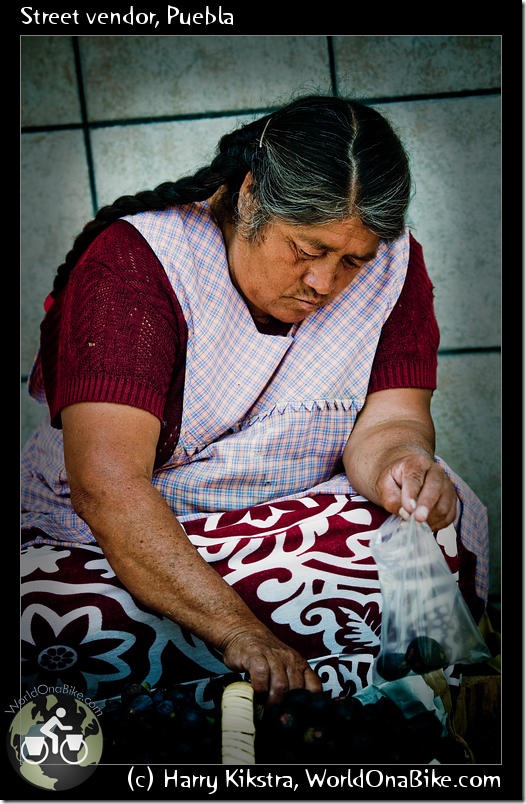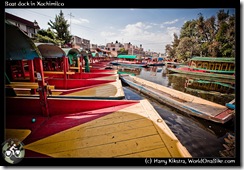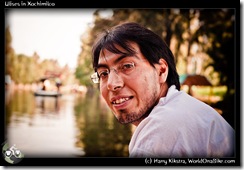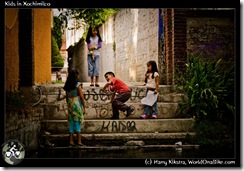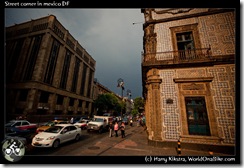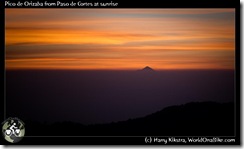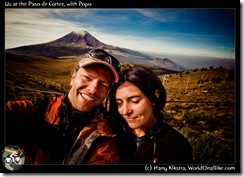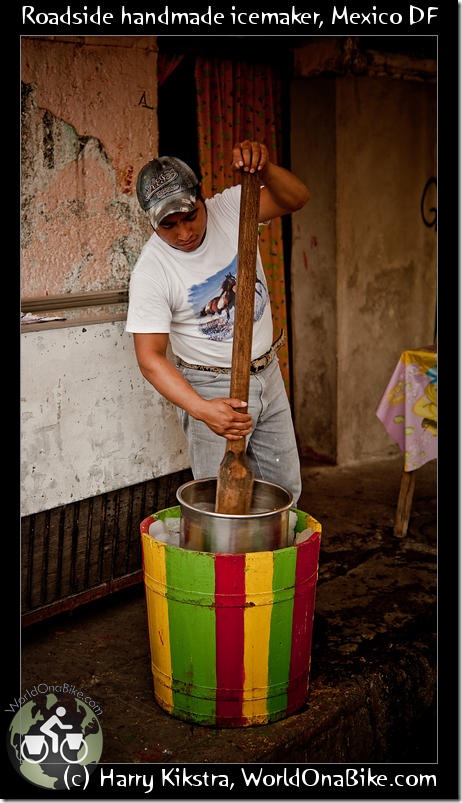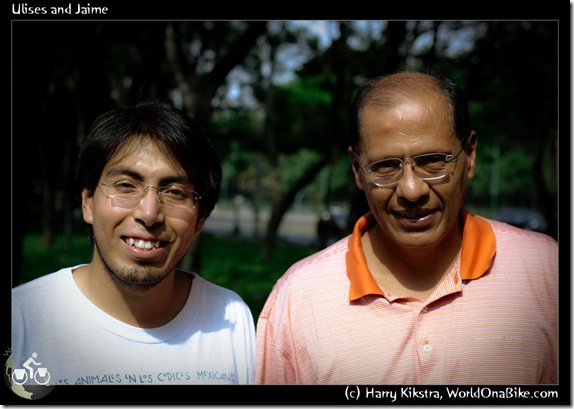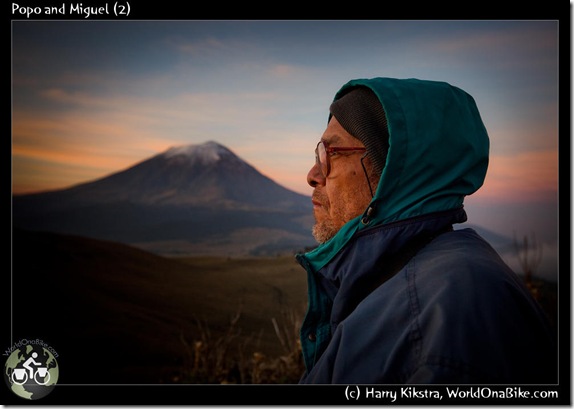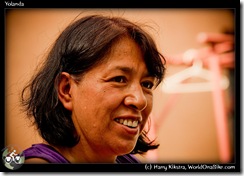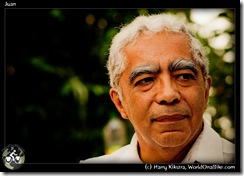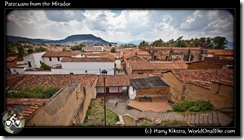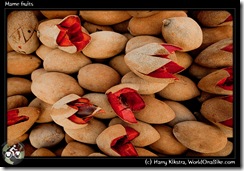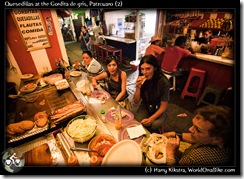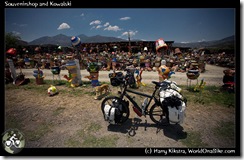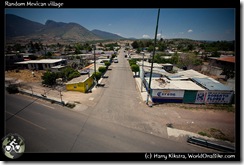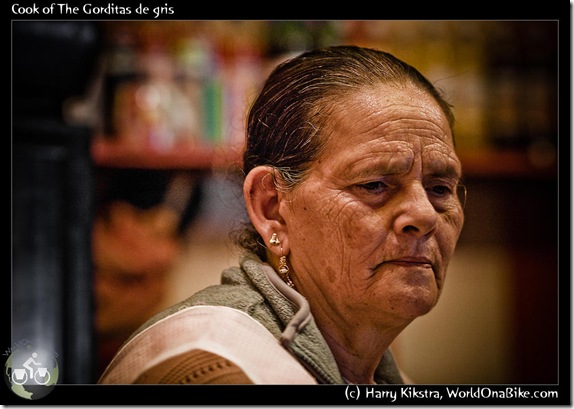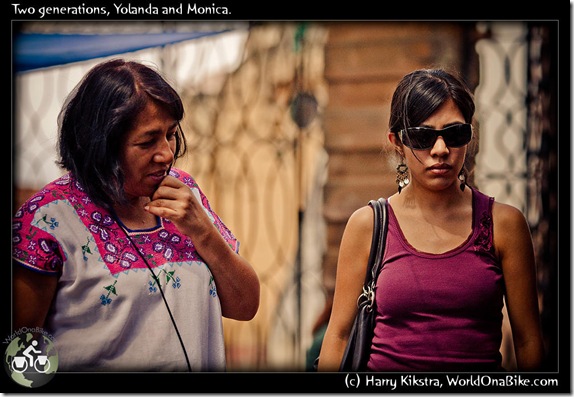1000 Americans: street vendor selling fruit, Puebla, Mexico
September 18, 2009 by Harry
Filed under 1000 Americans
This woman was sitting on the sidewalk, next to a restaurant, trying to sell the few bags of fruits she brought from the land.
Many poor farmers are trying to make ends meet by selling their goods in the big cities.
1000 Americans: balloon seller, Puebla, Mexico
September 18, 2009 by Harry
Filed under 1000 Americans
Armed with a huge smile, this friendly fellow sells all kinds of balloons to Mexican tourists, visiting the Zocalo of Puebla.
He enjoys the city and is already looking forward to the independence celebrations that are scheduled for next year, the public clock behind his mobile shop is counting down the days.
1000 Americans: Samuel & Emilia, Puebla, Mexico
September 18, 2009 by Harry
Filed under 1000 Americans
Samuel & Emilia have build up a popular family restaurant in Puebla, which is now mainly run by their sons. They had invited us into their home and made sure we were well taken care of.
They were worried about our trip and when we left Puebla, they hugged us close and shed some tears when praying for our safe journey. We are not religious ourselves, but the care and love of people that were strangers 3 days before keeps on surprising and warming us. So maybe the prayers do help as we will take care, so we can meet more great people like them and maybe one day return the favour.
Day 332-335: 8-11 June: Mexico City-Cholula, canals, interviews, city and volcanoes
September 16, 2009 by Harry
Filed under Trip reports, North America, Mexico, Central Mexico
Cycling through the outskirts of Metepec was still ok, but when we reached the main road from Toluca to Mexico, we had to use all senses we had to stay alive. We stopped at a gas station 20km out of town, as it was no use to try to cycle into the city any farther. There was a big climb ahead, the toll roads was completely full with cars and the free road even fuller, but then with trucks as well, neither having a decent shoulder for cycling.
We got a ride from a nice guy who worked for a TV station in the city. He took us over the high pass and down to one of the biggest cities in the world: depending on your definition, around 20 million people live in the valley!
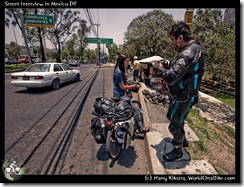 He dropped us off at his office, conveniently situated near the ‘periferico’, the huge highway, circling all around the centre of Mexico City. We were on our way to Ulises, yet another CouchSurfing host. According to the map, it was only about 10km to his house.
He dropped us off at his office, conveniently situated near the ‘periferico’, the huge highway, circling all around the centre of Mexico City. We were on our way to Ulises, yet another CouchSurfing host. According to the map, it was only about 10km to his house.
The periferico was the logical and fastest way, but filled with fast traffic as well, which we were not. Luckily, there was another road right beside it, with traffic lights and less hurry. As we still had some leftover free miles, we made it to Ulises’ area quickly, only interrupted by a taxi strike that had blocked some roads. Just after passing the blocked area, a TV reporter on a motorcycle did a quick interview with us, right on the street, not sure if it made it to the evening news.
We made it safely to Ulises’ house, but could have had some serious trouble as several metal drain covers were missing on the road, exposing holes without visible bottom, and 60cm/2ft across.
Ulises and his family welcomed us with open arms and treated us to some more Mexican dishes. Forget about Taco Bell, if you love real food (duh), you need to visit Mexico sometimes, as every region has its own different tasty specialties.
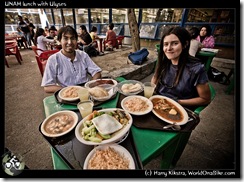 Ulises is studying engineering, specializing in the movements of the earth underneath the large buildings in the historic centre. he could as well been a professional guide if he wanted, as he shared his encyclopaedic knowledge about the culture and history of the City.
Ulises is studying engineering, specializing in the movements of the earth underneath the large buildings in the historic centre. he could as well been a professional guide if he wanted, as he shared his encyclopaedic knowledge about the culture and history of the City.
It was a shame that we had to rush, as there are many things to see in the city, that actually consists of many smaller towns and neighbourhoods, all absorbed into the giant metropolis, but with their own character and attractions.
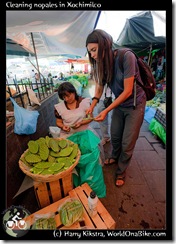 We ate a great and cheap lunch at the huge UNAM University complex, actually a city in itself, where the future of Mexico is being shaped. In the afternoon we visited the market and historic centre of Xochimilco, in the South part of the city.
We ate a great and cheap lunch at the huge UNAM University complex, actually a city in itself, where the future of Mexico is being shaped. In the afternoon we visited the market and historic centre of Xochimilco, in the South part of the city.
Ivana took a quick lesson how to prepare the nopales, the flat cactus leaves that is a popular vegetable. We relaxed and took a Gondola tour through the ancient canals that are still open and of course enjoyed more paletas and drank a ‘pulque, the ancient fermented drink that is still popular.
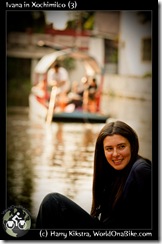 For about USD $10 you get a private boat for an hour, complete with a gondolier slowly pushing the boat through canals lined with nice houses & lush green trees.
For about USD $10 you get a private boat for an hour, complete with a gondolier slowly pushing the boat through canals lined with nice houses & lush green trees.
It was low season and not busy, but besides a few other boats with tourists, there are usually also boats selling food, drinks and souvenirs, and even some Mariachi boats with a complete orchestra that will play a song for a small charge. There are party boats where the youth come to drink and dance and complete families have reunions and a good and relaxed time, while floating slowly on the ancient waters.
You would have no idea that you are in one of the largest cities in the world, that was completely shut down a few weeks before because of fear for the ‘swineflu’.
Life in the city
There are enough sights, museums and monuments to keep you busy for weeks, if not months in Mexico City. The centre is well-known, the main square (where photographer Spencer Tunick once captured a record 18,000 nude people, a shock to the Catholic country) with the nearby ruins, government buildings, huge flag and the grand cathedral. As we had little time to do the city justice, we opted to see some of the lesser known pretty places where people actually live and work. There are parks, a small Chinatown, many big office buildings and all kinds of museums and interesting buildings.
We walked and rode the bus and the infamous subway between all of them and noticed that:
- nobody was wearing the mouth covers we saw in the news, just some people serving in restaurants &
- we did not get robbed, pick pocketed, kidnapped or molested once, how weird is that!
In the evening we visited some older towns that had been swallowed by the city. Friendly Tlalpan was as quiet as any small country town and beautiful Coyoacan should be one of the Pueblos Magicos, as pretty and relaxed as it is. Nope, again, no robberies and the air was clean.
10th June 2009: Interview and into thin air!
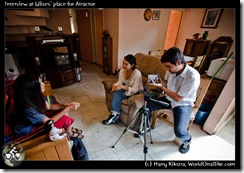 The next morning we were interviewed by some nice guys, for a new online magazine, called Atractor; the interview can be seen online here.
The next morning we were interviewed by some nice guys, for a new online magazine, called Atractor; the interview can be seen online here.
We had told Ulises that we wanted to see the Paso de Cortez, the famous mountain pass between the mountains Izta & Popo, where Cortez made his way to the valley. Ulises advised against cycling out of the city and as he loved the place, he offered to bring us there with his small car. 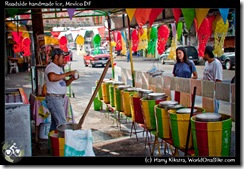
After lunch (Chicken with green mole!) we loaded our bikes on the bike rack, just fit all the bags inside and headed out the city. We stopped at one of the many handmade ice-cream stalls and continued up and over several nice little towns, situated on grassy fields.
The actual road up to the pass was steep, but paved and even though it rained, we slowly rose above most of the clouds, feeling happy we were not cycling/pushing our bikes through the rainy forest. The pass and a visitor centre are at about 3500m/12,000ft altitude, but the huts and camping spaces are higher.
We continued on a slippery and rocky unpaved road and made it all the way up to a large hut. It seemed deserted, but after knocking repeatedly, the guardian Miguel opened up and let us in. We had brought our tent, but for a few pesos, we could stay in the cozy hut, so we opted for that instead, enjoying the sunset behind Popocatepetl (‘Popo’), with 5452m/18,000ft the 2nd highest mountain of Mexico.
Miguel enjoys living between the mountains and had taken thousands of pictures of the mountains and the wildlife on it and showed us many great ones on his laptop, while we ate some snacks together for dinner.
Popo, the warrior and Izta, the sleeping woman
Popo can no longer be climbed, as it is still very active and the constant fumes are lethal. Popocatepetl means ‘smoking mountain’ and only 4 years ago a large eruption shot 5km into the air keeping 30 million people that will be impacted by a larger blast awake…
Iztacihuatl (‘Izta’) on the North side of the pass and with 5220m only a few hundred meters lower, is dormant and still climbable, though the glaciers are shrinking. We did not have any glacier gear so just stuck to enjoying the magnificent mountains from the pass.
There are a lot of variations on the legend of Popo & Izta. Basically warrior Popo was in love with Izta, but was told by her parents that she had died when he was in battle. Izta was told the same about Popo and died of grief. Popo returned to find his loved one dead and laid her on the land, while resting sadly besides her.
This is why Iztacihuatl is known as ‘The Sleeping Lady’, as on clear days after snow, the mountain scarily resembles a woman lying down on her back, with the classic Volcanoe-shaped Popo at her feet. The several summits are known as the Knees, the Head and the breast.
The next morning we woke up early to see the sunrise with Miguel. It was cloudy, but far away we could see the perfect shape of the summit of Pico de Orizaba, the highest mountain of Mexico (and 3rd of North America, after Denali & Mount Logan). As to salute the sun, Popo shot a small eruption into the multicoloured sky.
We love seeing the cities and how the people live in faraway countries, but natural shows like these always impress more than anything else…
.
To protect the bike as well as the car, we mountain-biked down to the pass while Ulises drove the car with the luggage down. We loaded our bikes up at the pass and said our goodbyes and thank-you’s to Ulises who had helped us out so much.
The east side of the Paso de Cortez is unpaved but the first few kilometres the smooth volcanic road was gentle enough. However, once we entered the forest again the road became horrible, slowing us down to protect the bikes, luggage and our spines. Big rocks were on the road and it was impossible to go fast, even though it was so steep we had to brake constantly. This lasted an hour or so, and if you ever are thinking about it: do NOT try to cycle up this side unless you are a professional mountainbiker without luggage…
We had lost a lot of altitude, but luckily there were a few free miles left when we hit the pavement and we zoomed through the fields towards Cholula. Usually we aim for the church if we want a place to have lunch as usually the Catholics have claimed the best and culturally richest parts of all Latin cities and normally the places are very beautiful.
In Cholula we had to search a bit for the pretty zocalo as Conquistador Cortes had almost 40 churches built after taking the city, but we ended up in the park, eating and relaxing from the downhill, only disturbed by a series of processions that came with terrible music and loud bomba’s, very noisy explosives shot into the air.
We had aimed to get to Puebla but stayed in Cholula that night with another CouchSurfer that offered a last-minute couch. We almost passed the giant Piramida Tepanapa, unnoticed as it is so big and covered with grass, that it looks like a huge hill. As often, there is a Catholic Church built on top, but they also might not have known that there was the largest pyramid on earth underneath.
Cholula is nowadays connected with Puebla, but in order to see more of the latter, we decided to move to Puebla, to see the often acclaimed city with our own eyes… We still had to rush, but my feet had started itching when I had seen the highest mountain in Mexico from afar… Would there maybe be time to… ? Tune back in to WorldOnaBike next time 🙂
Kowalski! Status report!
- Our bikes survived the downhill, though Ivana got a flat tire on the sharp rocks there.
- Knees and back are ok, but we are getting a bit nervous as we have to be in Cancun within 2 weeks…
- Total km cycled (excluding rides): 10,370 (about 6500 miles)
- More pictures of Xochimilco and Popocatepetl can be found on the picture page: http://harry.biketravellers.com/photos . as always, larger versions of the images appear automagically when clicking on the small versions (when reading this on http://WorldOnaBike.com). Try it!
1000 Americans: Roadside Ice cream maker, Mexico City
September 16, 2009 by Harry
Filed under 1000 Americans
On the South Eastern outskirts of Mexico City, an area is known for the many ice cream makers.
They serve delicious handmade icecream, prepared and cooled by turning a metal bucket inside a wooden bucket filled with ice.
You want chile or tequila on your coconut ice cream? No problema…
1000 Americans: Generations: Ulises & Jaime, Mexico City
September 16, 2009 by Harry
Filed under 1000 Americans
Ulises and his father Jaime live in the Southern part of one of the largest metropolitan areas in the world: Mexico City.
Jaime teaches at the university, Ulises is still studying, finishing his thesis about the causes effects of the ‘sinking buildings’ in the City. Together they know more about the history and culture of the area than Encyclopedia Brittanica 🙂
1000 Americans: Miguel & Popo, Mexico
September 16, 2009 by Harry
Filed under 1000 Americans
Popocatepetl is the active volcano close to Mexico City.
Miguel has been living close to the volcano for many years and has captured the many eruptions as well as the beautiful flora and fauna surrounding the volcano with his camera, rising before dawn in the hut he is guarding and living in, at 3800m/13,000ft altitude.
Day 325-331, 1-7 June 2009: highland magic in Morelia
September 14, 2009 by Harry
Filed under Trip reports, Tips & Tricks, North America, Mexico, Central Mexico
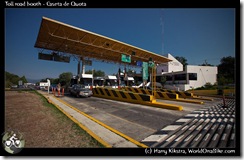 We were dropped off in the morning at our favourite pick-up spot: the tollbooth of the quota. For once we were not the only persons there without a car, as a demonstration of angry teachers was about to commence.
We were dropped off in the morning at our favourite pick-up spot: the tollbooth of the quota. For once we were not the only persons there without a car, as a demonstration of angry teachers was about to commence.
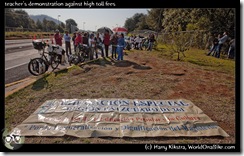 The toll roads in Mexico are very expensive, most truck drivers and definitely the underpaid teachers cannot afford to use them, so they were going to occupy the booths and let everybody go free as a protest.
The toll roads in Mexico are very expensive, most truck drivers and definitely the underpaid teachers cannot afford to use them, so they were going to occupy the booths and let everybody go free as a protest.
Unfortunately the guy that Ivana asked to give us a ride to Morelia had already paid. When he stopped to load our bikes in the back of the truck, he noticed the few dozen of people waiting and carefully asked ‘How many people need a ride again?’ 🙂
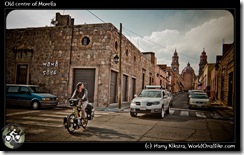 We had not expected to get to Morelia so soon, but it was nice to have some time to cycle through the old city. Morelia is one of the reasons people should visit Mexico: it has a wonderful historic centre, full of culture and with loads of buildings that are older than anything in the US. The university city is full of young people and there are plenty nice places to eat, drink or party if needed.
We had not expected to get to Morelia so soon, but it was nice to have some time to cycle through the old city. Morelia is one of the reasons people should visit Mexico: it has a wonderful historic centre, full of culture and with loads of buildings that are older than anything in the US. The university city is full of young people and there are plenty nice places to eat, drink or party if needed.
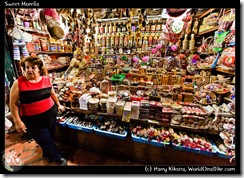 We had been invited by our new CouchSurfing friend Monica to stay with her family, we were already the 3rd cycling couple they had hosted. Monica and her family took great care of us and we stayed much longer than planned. We still had a deadline to meet, but the generosity of Monica, her mother Yolanda, father Juan and brother Juan Pablo kept us relaxed.
We had been invited by our new CouchSurfing friend Monica to stay with her family, we were already the 3rd cycling couple they had hosted. Monica and her family took great care of us and we stayed much longer than planned. We still had a deadline to meet, but the generosity of Monica, her mother Yolanda, father Juan and brother Juan Pablo kept us relaxed.
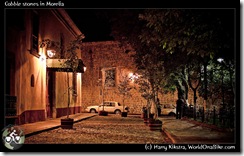 Yolanda is not just a great conversationalist with a lot of knowledge about history, culture and politics, but also a great cook. She surprised us every day with new local dishes, made with fresh and tasty natural ingredients only.
Yolanda is not just a great conversationalist with a lot of knowledge about history, culture and politics, but also a great cook. She surprised us every day with new local dishes, made with fresh and tasty natural ingredients only.
A welcome relief from the fast-food stores that are popping up everywhere in Mexico and from the pre-processed chemical packages that are sold as ‘food’ in the many small supermarkets. She even gives free classes about nutrition in schools and every meal was a feast.
We got to rest and recover from the hot Mexican coast My cut healed well and left only a small scar in the shape of a ‘7’, which is actually pretty cool 🙂
Patzcuaro, the magic town
When we mentioned that we would have to leave soon, they said that we could not go without seeing Patzcuaro, and they took us to this historic town between Uruapan & Morelia: one of the few dozen ‘Pueblos Magicos’, a list of less than 30 ‘magical cities’ of Mexico. Places that give you that special feeling…
We enjoyed the lake, ate real quesadillas on the market, had handmade ice-cream at the main square and admired the historic buildings and culture. Many local artists are producing and selling their artesanias on the streets and in little shops around town.

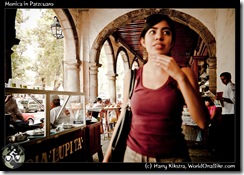
.
As in more historic places in Mexico it is illegal to have big loud advertising in the centre. All shops have the same colours and use the same fonts to advertise their name outside, which secures a wonderful low-key relaxed feeling.
So even though Burger King might have infiltrated in the main square commercial zone, you won’t know it is there until you are almost inside. But why eat there anyway, when there are delicious huge quesedillas for USD$0,50 and tons of unknown but cheap and tasty fruits instead?
Goodbye to Morelia
 Monica had already taken us a few times to some nice dinners and walks in the historic centre of Morelia and even organised a CouchSurfing meeting for us.
Monica had already taken us a few times to some nice dinners and walks in the historic centre of Morelia and even organised a CouchSurfing meeting for us. 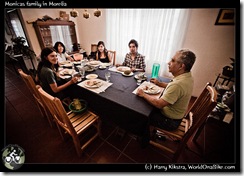
It was hard to say goodbye to this generous family, as many times before we felt we had taken more than we could give in return. We felt privileged to be a part of the family for while and to see yet another side of the diverse Mexican culture.
Back on the road again, heading for DF. Paletas & hills.
If you are in another country and you are heading for ‘Mexico’, you are heading for the country. Once you are there and you are still heading for ‘Mexico’, everybody knows you are going to the capital with the same name. I must admit that I knew nothing much more about Mexico City than that it is one of the largest cities in the world, with accompanying pollution and crimes. Recently, it was known as the ‘Swine flu capital’, though all news sources in Mexico report that the flu originated in the US, so who should you believe?
Anyway, as we always like to see things for ourselves rather than trusting media copycats, we decided that we should at least try to visit the Capital.
Monica & Yolanda guided us out of Morelia and pointed us to the new toll road. Unfortunately the arrogant boss of the accompanying complex would not let us cycle, nor leave us waiting for a ride. All the guards said that once the chief would be away, we would be fine. In the end we managed to ask for a ride and get our bikes loaded on a truck while the driver was paying his toll.
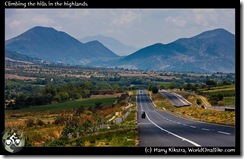 The car dropped us off at Zinepecuaro, where we enjoyed the first of many ‘paletas’, locally made ice-lollies made with big chunks of pure fruit, like Guanabana, coconut, pineapple or my favourite, mango with chile: cold, sweet and spicy!
The car dropped us off at Zinepecuaro, where we enjoyed the first of many ‘paletas’, locally made ice-lollies made with big chunks of pure fruit, like Guanabana, coconut, pineapple or my favourite, mango with chile: cold, sweet and spicy!
A steep road headed up to the main toll road between Guadelajara & Mexico city. The toll booth attendant did not even see us when we sneaked past. We could try to catch a ride here, but decided that we try some highland cycling instead. We regretted that soon as the next 15km was constant and very steep uphill. 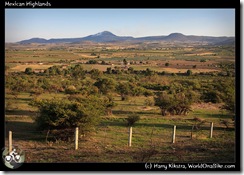
Even though we were at about 2400m/8000ft, it was hot and we had run out of water on the long climb. At the summit we got a bag full of sweet strawberries from a street vendor, which we enjoyed between the pine forests of the highlands.
After an initial downhill there was another smaller hill to climb but then we could enjoy our well-earned ‘free miles’, all the way down to the city of Maravatio. We cycled into town and saw the sign of the Cruz Roja, the red Cross.
If you are ever cycling in a town and have no idea where to stay safely and cheaply, here are some recommended choices, in no particular order, but generally valid all over the world:
- The fire station (Bomberos in Latin America). They usually have nothing much to do and enjoy the company, usually have some extra rooms or at least a safe place to camp
- The Red Cross: same as the Bomberos, + benefit of providing medical help if needed
- The Police: even though sometimes they have a bad name, generally speaking it is a lot safer to stay between police men than between the thieves they are trying to catch 🙂
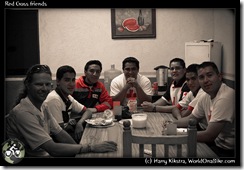 We got some water from the friendly nurses at the Cruz Roja and cooked our spaghetti outside the main entrance. Just after had put up our tent, the team leader cam out and offered us to stay inside instead and use the WiFi as well, which was of course gladly accepted.
We got some water from the friendly nurses at the Cruz Roja and cooked our spaghetti outside the main entrance. Just after had put up our tent, the team leader cam out and offered us to stay inside instead and use the WiFi as well, which was of course gladly accepted.
It was nice to see young (most were between 16 & 20) volunteers, trying to help out in the community, while being educated.
The following day we still had some free miles saved and the kilometres passed quickly through gentle hills and green fields passing over small towns.
It was still a long way to the City and so we stopped at the next tollbooth, where we got a ride fairly quickly. Fortunately we passed the busy madness of Toluca city, and got dropped off right in Metepec, where Monica’s aunt & uncle live.
When we cycled to the charming main square to call them for directions, a group of young cyclists came up and started asking questions about our trip. They were really interested and also used the opportunity to practice their English. They guided us through the small streets, stopping cars to let us pass easily and even called Monica’s family when needed. It was great to have such a young and enthusiastic cycling escort!
We were received with open arms by Laura & Roberto and their son Beto in their house outside of town. To the west we could see the impressive massif of Volcan de Toluca, to the east were the high mountains separating us from one of the largest urban zones in the world, currently feared by the world because of some strange virus… Mexico City, here we come!
1000 Americans: cook of the ‘Gorditas de Gris’, Patzcuaro, Mexico
September 14, 2009 by Harry
Filed under 1000 Americans
She works all day in the dark alleys of the Patzcuaro market, making loads of Quesadillas. Not just the small flat tortillas with a bit of cheese you get elsewhere, but large fried food, filled with cactus, meat, beans or other options and, of course, cheese.
1000 Americans: Yolanda & Monica, Morelia, Mexico
September 14, 2009 by Harry
Filed under 1000 Americans
Actually the photo above is taken in Patzcuaro, but Yolanda & Monica live in Morelia. Monica is studying art and will be off to finish her studies elsewhere soon, either elsewhere in Mexico, or in the US or Europe.
Her mother Yolanda use to have a computer shop with her husband Juan. Now she gives courses for future moms as well as nutritional education to schools, and practices her knowledge by creating healthy and tasty food for her family and friends.



